


Ready position:
Volleyball is a sport which requires quick reactions and rapid, controlled movements over relatively short distances. It can be described as a ‘readiness-state’ sport. This state of readiness is required both physically and mentally.
A sense of readiness can be portrayed by a correct body shape:
Key characteristics:
• Feet shoulder-width apart
• Knees bent and inside the line of the toes
• Weight forward with the knees loaded
• Spine straight
• Hands in front of the body, ready to move
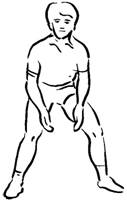

MOVEMENT (footwork)
How to Start
Movement should start from a readiness posture. Forward movement is initiated by a slight lean forward, causing a loss of balance, and then a step is taken to prevent the player from falling over. This forward shift of weight can be initiated by pressing the knees forward and inwards. When moving, the hips and eyes should stay parallel (and not bob up and down). This helps in keeping a constant perspective and assists in judging the flight of the ball.
Players should be asked to imagine that they have a glass of water on their head, and that they must not spill a drop.
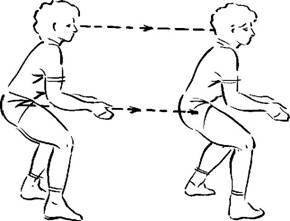
Moving Sideways:
Movement to the side is made by using a side-step for shorter distances and for novice players.

REMEMBER The hip line of the player should trace a straight line when he is moving. Keep eyes level and stay low.
Passing
1-Volley:
The volley is a two-handed pass played above the forehead. With its high and slow trajectory, it gives beginners the best chance to read the flight of the ball and to move to the contact point, thus making it the ideal starting point for teaching the game. Using only the volley it is possible to get a 1 v 1 game going very quickly. Once mastered, the volley is the most accurate method of passing the ball.
Technique Description:
The player should:
• be ready to move to the ball
• watch the ball and anticipate where it is going
• move quickly to the interception point (midline of the body, ball above hairline) maintaining good body shape; be behind and under the ball
• be balanced and facing the direction in which he/she wants to play the ball before the ball.
• have his/her body under the ball, with the knees bent and arms relaxed
• contact the ball above the hairline, on the midline of the body
• use a 1-2 rhythm to play the ball; i.e. count one – down beat with the knees bending farther as the hands go up to contact point, count two – extend from the knees through the ball in direction of the target (using the whole body, not only the arms and hands)
• finish the action physically by extending to the target, and mentally by seeing in the mind’s eye the correct execution
• recover and be ready for the next action; e.g. if the player has played the ball to the setter, he/she should prepare to cover the attacker, or should return quickly to the defensive base position if the ball has been played over the net.
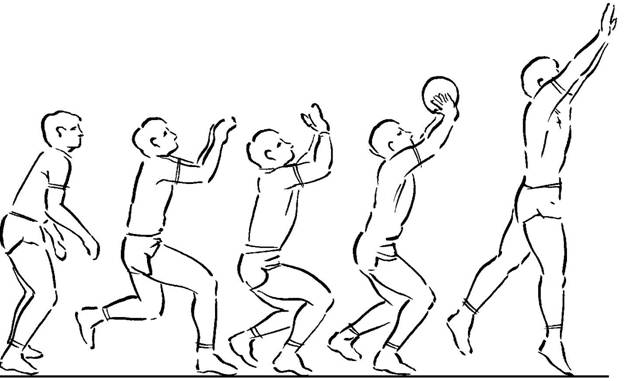
Ball Contact:
• The hands are open, in the shape of the ball
• The index fingers and thumbs form a triangle; index fingers and thumbs are the same distance apart, 2.5cm-5cm
• The thumbs should point at the opposite ear
• The forearms make a second, bigger triangle
• The ball is contacted with the pads of the thumbs along the length of the forefinger and the pads of all the other fingers
• The player should try to play the ball quietly with relaxed arms, wrists and fingers.
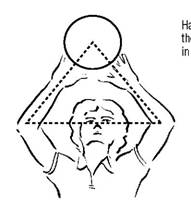
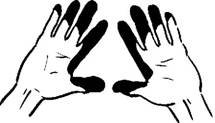
THE FOREARM PASS:

The forearm pass, often called the dig, is a technique unique in style to volleyball. It is used to play a ball which is travelling too fast and low to volley, and is performed by bringing the forearms together to make a platform, off which the ball rebounds. It is used most often to receive the service or an attacking shot from the opponents, and it is necessary that this important skill is introduced and mastered early in the development of players
Technique Description – Forearm Pass
The player should:
• be alert and ready to move to the ball.
• watch the player playing the ball, watch the ball and anticipate where it is going
• move quickly to the interception point (midline of body, ball well in front of body and between the waist and knees), maintain good posture and create space in which to contact the ball well in front of the body.
• Before the ball arrives be in a balanced position, feet slightly more than shoulder width apart, knees bent and shoulders relaxed.
• the hips should be back and the arms and hands extended in front of the body.
• the ball is contacted on the midline of the body between the knees and the waist; the ball is played on the forearms.

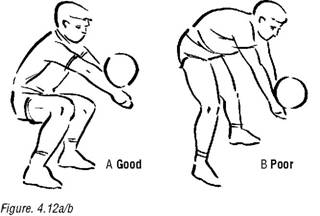
THE SERVICE
The serve is used to start every rally. It is the only skill in volleyball over which the player has complete control (closed skill). Initially it is necessary to develop a serve which is consistently safe, i.e. over the net and into court, so that the team has an opportunity to score points. As the standard of play improves, it is necessary to try to create some pressure on the opponents by powerful or tactical serving.
Types of Serve:
There are many different serves:
• Underarm
• Overarm float
• Overarm topspin
• Roundhouse
• Jump
When introducing the game of volleyball, service reception skills are perhaps the most difficult to master and so the service should remain conditioned throughout the small-sided game period, for example restricted to volley serve or underarm serve. Only when a team’s service reception skill improves, should overarm service techniques be allowed. Both the underarm and a simple overarm serve are described here.
The underarm serve is easy to introduce and learn; it is safe and yet it can be used to develop the tactical awareness of the server (who to serve at, where to serve to, etc.) It is not a very powerful attacking serve, however, and as the reception skills of the players improve the overarm serve should be developed.
Underarm Serve:
• The player should select a position behind the base line. Feet should be a shoulder width apart, left toe pointing to the target, right foot behind and to the side of the left foot at about forty- five degrees. This should be a comfortable and balanced stance.
• The weight is mainly on the back (right) foot; the knees are bent.
• The ball is held in the left hand, elbow comfortably bent at about waist height and in front of the right hip.
• The hitting hand can be either closed in a fist or kept open.
• The hitting arm swings through in a straight line, brushing the right hip.
• The body weight is transferred from the back to the front foot as the hitting arm swings forward and the ball is struck.
• The hitting hand strikes the bottom half of the ball (to ensure that it goes up and over the net) and follows through in the direction of the target.
• The player moves onto court to take up his/her defensive position.

Overarm Serve:
• Feet should be shoulder width apart, left toe pointing to the intended target, right foot behind and to the side of the left foot, at about forty five degrees. The weight is mainly on the back (right) foot, the knees are bent, the back is straight. The player should be comfortable and balanced in this stance.
• The ball is held on the fingers of the left hand, in front of the right shoulder.
• At the same time as the left hand tosses the ball, the right arm moves back to initiate the striking action. The right elbow is kept high (above shoulder level) during the action. The ball should be at the apex of its toss when it is hit by the serving hand.
• As the right arm and hand comes forward to strike the ball, the body weight is transferred from back to front foot.
• The hand is open and the wrist and palm are tense as they strike the centre of the ball.
• The hitting hand stops on contact with the ball and should finish facing the target.
• The player should move quickly onto court to take up his/her defensive position.
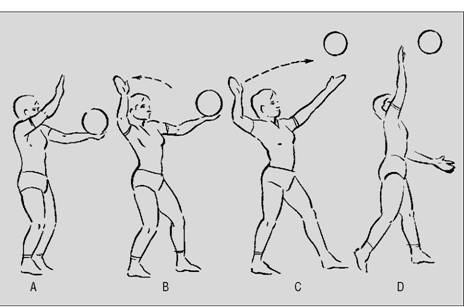
THE SMASH
The smash is the principal attack shot used in volleyball. The player runs in and jumps above and close to the net (about 1 meter away) to hit the ball with one hand down into the opponents’ court. The main purpose for a team’s using its three touches is to set up an opportunity to use the smash. Players are normally easily motivated to practice the smash, but it is important that players work on the whole sequence of passing, setting and smashing the ball.
Technique Description:
• The arms are swung back behind the body on the second (right) step.
• The smasher jumps off two feet to prevent forward drift into the net.
• The left, non-hitting arm leads the jumping action and is used to sight the ball.
• The ball is contacted along the line of the smash approach between the head and the hitting shoulder, in front of the body and with the hitting arm fully extended.
• The player lands in a balanced position on two feet and absorbs the force of landing by flexing the knees.
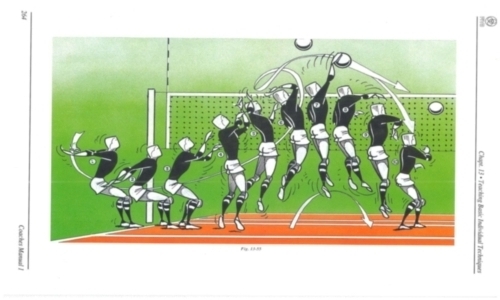
Ball Contact:
-Power is generated by using the whole of the body weight through the ball in the direction of the smash.
-Control of the ball and topspin is achieved by hitting the ball with the palm of the hand, wrapping the fingers over the ball and snapping the wrist forward on contact with the ball.
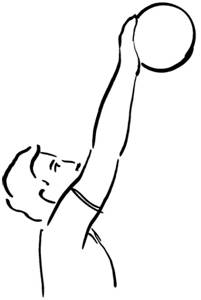
THE BLOCK
The block is the first line of defense against the smash. It may be performed by one, two or three front-row players who jump at the net to stop the smashed ball from crossing the net and to deflect it back into the opposition’s court. The block can also stop the smasher from hitting a particular area of the court.
Blocking is a difficult skill to master, but time spent practicing it will be well rewarded. Good blocking will wins points.
Technique Description, the player should:
• stand about half a meter from the net, feet shoulder width apart, knees slightly bent with hands in front of the shoulders (elbows forward).
• be balanced and ready to move to either side depending on where the ball is set (See Figure).
• bend knees to ninety degrees and extend arms forcefully to assist jumping. (See Figure) To help stay balanced in the air, keep hips back and chin down (See Figure).
• Normally jump at the same time as the smasher jumps.
• If possible, reach over the net with the arms and hands to cut off the angle of the attack and to deflect the ball down into the opponent’s court, (See Figure).
• the fingers should be spread and thumbs almost touching to form a solid ‘wall’ which will not let the ball through, (See Figure).
• draw the arms back after blocking in order not to touch the net.
• bend the knees to assist in a soft, balanced landing and be ready to play the next action.
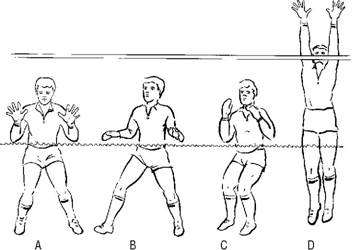
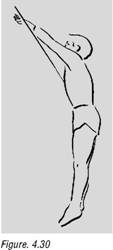
![]()
